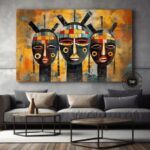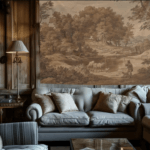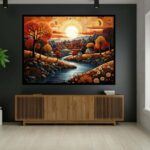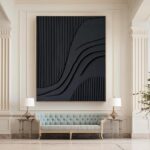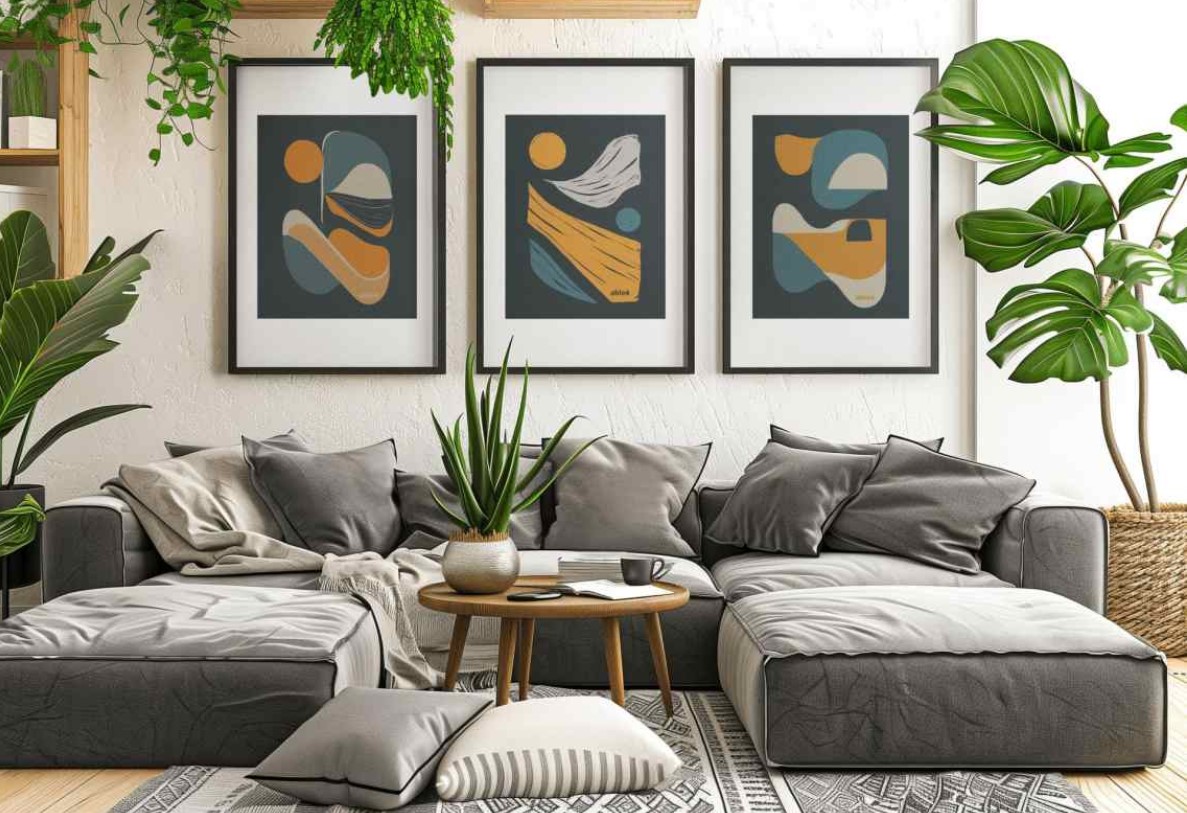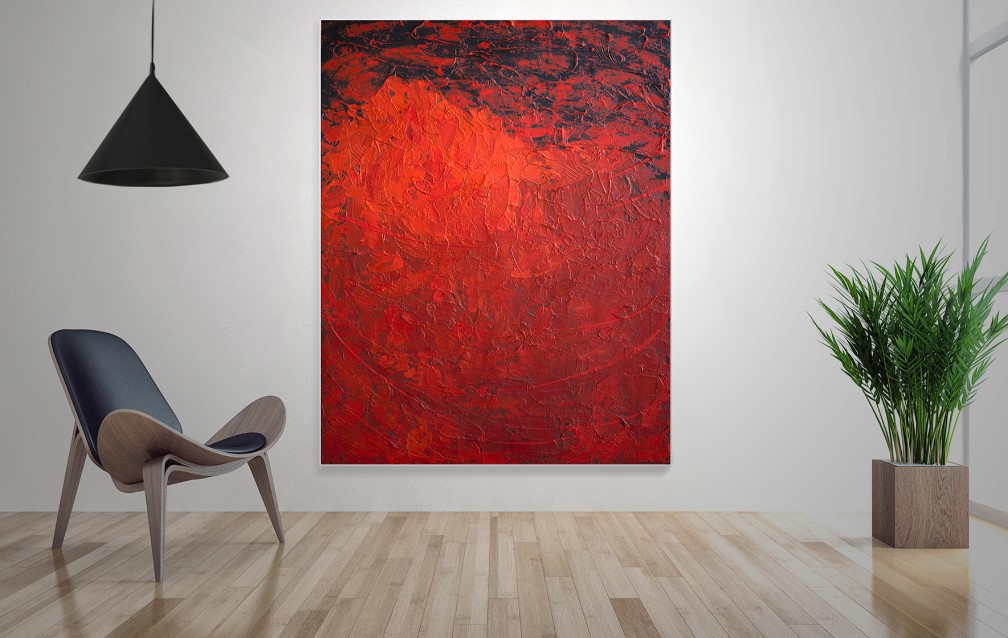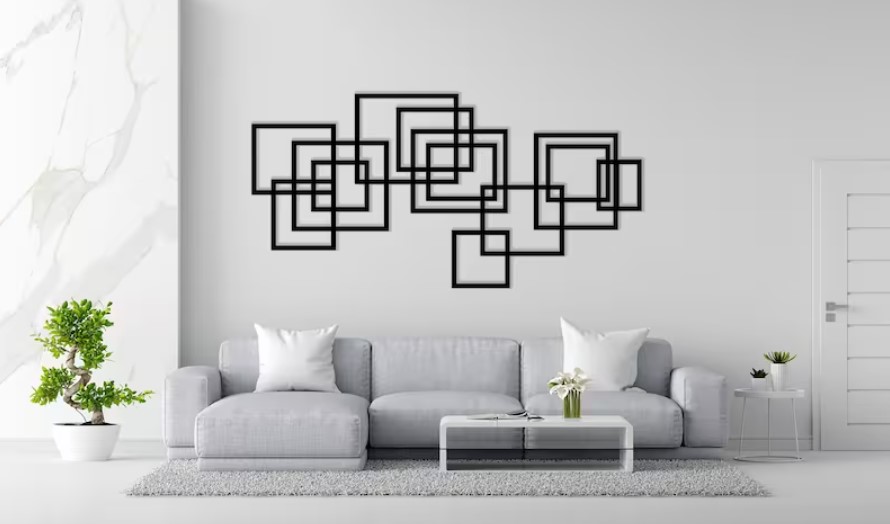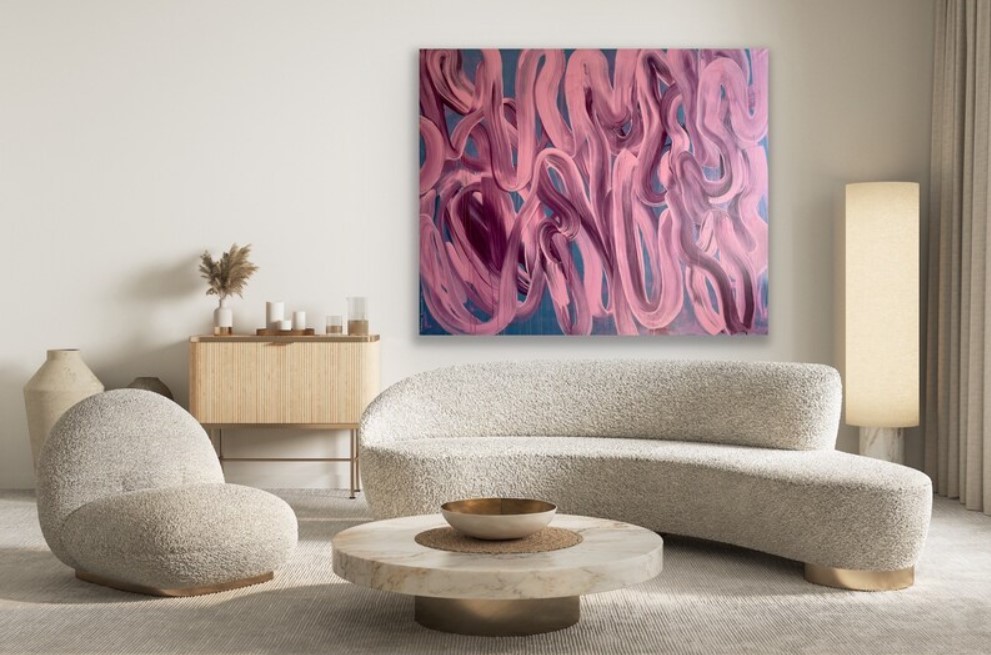Introduction
When decorating your home, the choices of wall art can dramatically influence the look and feel of your living space. Minimalist Abstract Art is among the most striking, versatile, and increasingly popular choices. This contemporary art style, known for its simplicity, clean lines, and open interpretations, is much more than just a visual statement—it’s an invitation to create a serene, cohesive, and stylish home environment.
In this blog post, we’ll explore how Minimalist Abstract Art can transform your home’s interiors and provide practical tips for incorporating it into various spaces, from living rooms to bedrooms, hallways, and beyond. Whether you live in a modern loft, a cozy farmhouse, or a sleek urban apartment, Minimalist Abstract Art can elevate your décor in unexpected and transformative ways.
What is Minimalist Abstract Art?
At its core, Minimalist Abstract Art emphasizes simplicity. It’s an abstract art that strips away excess detail, focusing on basic shapes, colors, and forms. The power of this art style lies in its ability to convey emotion or concept through minimal elements. Unlike other art forms that aim to depict recognizable scenes or objects, Minimalist Abstract Art invites interpretation through abstraction, creating an experience for viewers that is deeply personal and reflective.
This art form often uses a limited color palette—blacks, whites, grays, and soft neutrals—though bold, singular colors can also appear. The shapes are simple and often geometric: think circles, lines, squares, or organic, free-flowing shapes. When placed on the walls of your home, these designs can evoke a sense of calm, order, and openness, making them a perfect fit for the clean and uncluttered aesthetic that modern homes crave.


Minimalist Abstract Art as Decorative Wall Art
Wall art is more than just an accessory; it is an integral part of interior design. It sets the tone of the room, provides focal points, and helps to create a cohesive theme throughout your home. Minimalist Abstract Art offers the perfect blend of subtlety and impact, making it a highly versatile option for different interior styles.
Minimalist Abstract Art fits seamlessly in homes where the décor leans towards minimalism (think Scandinavian, Japanese, or modern design). Its clean lines and lack of intricate detail make it a natural extension of these design philosophies, where “less is more”. Even in more eclectic or traditional homes, the quiet power of Minimalist Abstract Art can create a refreshing balance, breaking up heavy textures or complex patterns with moments of calm and simplicity.


Exploring Categories of Minimalist Abstract Art for Home Décor
Here’s a more in-depth analysis of each category of abstract minimalism wall art, along with examples to illustrate how they can enhance home interiors:
| Geometric Shapes |
|---|
| Geometric minimalist art uses basic shapes—circles, squares, triangles, and lines – in balanced compositions. These artworks can range from symmetrical to asymmetrical designs, creating a sense of order or dynamic energy depending on the arrangement. |
| Example: A piece featuring intersecting black and white circles and squares can add a modern, structured look to a living room. In a home office, a minimal design with vertical and horizontal lines can create a calming yet focused atmosphere. |



| Monochromatic Art |
|---|
| Monochromatic art focuses on variations of a single color to create depth while maintaining simplicity. It highlights the beauty of subtle shades and gradients, offering a calming visual experience. |
| Example: A large monochromatic painting in varying shades of blue can evoke a peaceful, serene vibe in a bedroom. A series of grayscale art pieces can add understated elegance to a minimalist hallway. |



| Line Art |
|---|
| Line art uses simple, continuous, or broken lines to form abstract shapes. These minimalist designs are often used to depict human forms, faces, animals, or abstract patterns in a highly stylized manner. |
| Example: A single-line drawing of a human face in black ink on a white background creates an abstract portrait that’s both modern and personal, ideal for a contemporary living room or bedroom. |



| Organic Forms |
|---|
| Organic minimalist art features flowing, soft shapes inspired by nature, such as waves, leaves, or clouds. These shapes are less rigid than geometric designs, giving the artwork a natural, fluid feel. |
| Example: A large canvas featuring abstract waves in muted tones can evoke a sense of movement and tranquility in a living room, while curved leaf-like shapes in soft pastels might create a calming, nature-inspired theme for a bathroom or bedroom. |


| Negative Space Art |
|---|
| Negative space art plays with the concept of space around or between the subject of the artwork. It uses minimal design elements and allows the surrounding space to “breathe,” enhancing the minimalist aesthetic. |
| Example: A design where a single shape (like a circle) occupies a small portion of the canvas, leaving vast areas of blank space, could add a sense of openness and simplicity to an entryway or hallway. |



| Minimalist Typography |
|---|
| Minimalist typography incorporates abstract use of letters, words, or numbers in a design. The focus is less on the meaning of the text and more on the aesthetic appeal of the font, form, and layout. |
| Example: A large canvas with a single word like “Calm” in a simple, modern font, could work well in a bedroom or relaxation area, while a single letter with bold typography can add an intriguing focal point to a home office or study. |



| Color Blocking |
|---|
| Color blocking uses large areas of bold or muted colors arranged in simple, often geometric, compositions. This approach emphasizes the contrast or harmony between different shades. |
| Example: A canvas divided into two or three large, solid color blocks (e.g., a neutral beige with a deep blue or bold red) can create a striking focal point in a modern living room, adding depth without being overly complex. |



| Textured Minimalism |
|---|
| Textured minimalism incorporates the tactile qualities of the artwork, adding dimension to a typically flat composition. This might include raised surfaces, layered materials, or visible brushstrokes. |
| Example: A monochrome white canvas with rough, raised textures could create an interesting focal point in a minimalist living room. In a dining room, textured wall art featuring subtle, hand-applied layers of neutral tones can add depth and sophistication. |



| Minimalist Gradient Art |
|---|
| Gradient art involves a subtle shift in color tones or lightness, creating a seamless, calming transition between shades. These pieces often convey a serene and ethereal feel, perfect for quiet, reflective spaces. |
| Example: A gradient transitioning from soft blue to white evokes a sense of sky or water, making it a perfect backdrop for a bedroom or meditative space. Alternatively, a warm gradient shifting from pale orange to light pink can infuse warmth into a living room or hallway. |



| Abstract Symbolism |
|---|
| Abstract symbolism uses minimal symbols or icons to convey a deeper meaning. These symbols may be repeated, layered, or isolated in the composition, allowing the viewer to derive their interpretations. |
| Example: A minimalist piece featuring repeated abstract symbols, like circles or triangles, can add a sense of rhythm and harmony to a living room. A single, isolated symbol (like a simple sun or moon icon) can create a focal point in a more spiritual or reflective space, such as a meditation room. |



Each of these categories of abstract minimalism wall art offers unique ways to enhance different rooms and styles within your home. Whether you prefer the structured appeal of geometric shapes, the serene flow of organic forms, or the textured depth of tactile art, these minimalist designs allow you to express both simplicity and creativity in your interior décor.
How Minimalist Abstract Art Enhances Home Aesthetics
Adds Visual Interest Without Clutter: One of the biggest challenges in home décor is adding personality without creating visual clutter. Minimalist Abstract Art achieves this balance beautifully by being subtle yet impactful. Its simple forms catch the eye without overwhelming the space, allowing your room to breathe while still feeling complete.
Creates Focal Points: Minimalist art’s simplicity uniquely draws attention. When placed strategically, a large abstract canvas with clean lines and muted tones can create a powerful focal point in your living room, dining area, or bedroom. It can ground the space, giving the room a sense of cohesion and flow.
Amplifies Natural Light and Space: Another fantastic aspect of Minimalist Abstract Art is its ability to enhance the feeling of space and light. Light-colored minimalist pieces with soft tones or metallic accents can reflect natural light, making rooms appear more expansive and airy. This is especially effective in smaller rooms or apartments where space is at a premium.
Versatile for Different Interior Styles: Whether your home is modern, traditional, or somewhere in between, Minimalist Abstract Art adapts to your style. Its simplicity allows it to blend with various design elements, while still offering a unique contrast to more ornate or detailed pieces. This versatility is key to its growing popularity in home décor.
– Blue Minimalist Painting, Large Blue Wall Art, Blue Abstract Art, Abstract Painting on Canvas –



How to Incorporate Minimalist Abstract Art Into Different Rooms
Now that we’ve established the aesthetic power of Minimalist Abstract Art, let’s dive into how best to incorporate it into different areas of your home.
Living Room
The living room is often the centerpiece of the home, and the right wall art can significantly elevate its overall design. For minimalist interiors, choose a large, neutral-toned abstract piece to anchor the space. If your furniture is sleek and modern, go for a monochromatic piece with geometric shapes or lines. This will add texture and interest without overpowering the room. For eclectic or more traditional spaces, a minimalist art piece in bold, contrasting colors can provide a striking balance to other detailed décor elements.


Bedroom
Bedrooms are spaces for relaxation and tranquility, and Minimalist Abstract Art helps create a serene environment. Soft pastels or neutral tones in abstract patterns can enhance this calm atmosphere. Choose smaller, understated pieces above the bed or opposite the window to complement your bedding and other design elements. Consider art that reflects peaceful themes, such as flowing lines or simple organic shapes, to promote a sense of restfulness and calm.


Home Office
Minimalist Abstract Art can work wonders in a home office, especially if you need a space that inspires focus and creativity. Opt for bold lines, clean shapes, or a single impactful color that can energize the room without distracting you from your work. A minimalist piece can set the tone for a productive and uncluttered workspace.



Hallways and Entryways
These often-overlooked spaces can benefit immensely from the addition of Minimalist Abstract Art. Hallways are narrower and less decorated, making them perfect for minimalist pieces. Long, narrow artworks with simple shapes or a series of smaller, framed pieces can give these transitional spaces a sense of continuity and flow. Similarly, in entryways, minimalist wall art makes a subtle yet stylish first impression, setting the tone for the rest of your home’s aesthetic.


Tips for Choosing and Displaying Minimalist Abstract Art
![]() Size Matters: Choose art that is proportionate to the space. For larger rooms, go for oversized pieces that make a statement without overwhelming the area. In smaller rooms, opt for modest-sized art that adds to the décor without overpowering the space.
Size Matters: Choose art that is proportionate to the space. For larger rooms, go for oversized pieces that make a statement without overwhelming the area. In smaller rooms, opt for modest-sized art that adds to the décor without overpowering the space.
![]() Consider the Color Palette: Minimalist Abstract Art is often defined by its color choices. If your room is already full of color, choose minimalist art in black, white, or neutral shades to create a sophisticated contrast. Conversely, if your space is primarily neutral, a bold minimalist piece can add a pop of color without cluttering the room.
Consider the Color Palette: Minimalist Abstract Art is often defined by its color choices. If your room is already full of color, choose minimalist art in black, white, or neutral shades to create a sophisticated contrast. Conversely, if your space is primarily neutral, a bold minimalist piece can add a pop of color without cluttering the room.
![]() Placement is Key: The placement of your art can make or break the room’s design. In living rooms, large pieces work well above the sofa, creating a focal point. In bedrooms, consider placing minimalist art above the bed or on a blank wall opposite the window to enhance natural light.
Placement is Key: The placement of your art can make or break the room’s design. In living rooms, large pieces work well above the sofa, creating a focal point. In bedrooms, consider placing minimalist art above the bed or on a blank wall opposite the window to enhance natural light.
![]() Frame It Right: The right frame can elevate minimalist art without overshadowing it. For a truly minimalist look, opt for frameless canvas prints or simple, sleek frames in black, white, or metallics that blend seamlessly with the artwork and the room.
Frame It Right: The right frame can elevate minimalist art without overshadowing it. For a truly minimalist look, opt for frameless canvas prints or simple, sleek frames in black, white, or metallics that blend seamlessly with the artwork and the room.



Conclusion: Final Thoughts
Minimalist Abstract Art is more than just a trend—it’s a timeless design choice that elevates any home’s aesthetic. Whether you’re creating a calm, peaceful space or making a bold design statement, this style of art offers endless possibilities. Its clean lines and understated elegance allow it to enhance the aesthetics of any room without overwhelming it, making it an excellent choice for both modern and traditional interiors.
By thoughtfully incorporating Minimalist Abstract Art into your home décor, you can create a space that is not only visually pleasing but also a reflection of your style. Whether you prefer a calm, neutral palette or something with a pop of bold color, this art form offers a world of possibilities to enrich your living space.
| If you have any comments or questions about this post, please leave your feedback below. |




